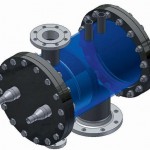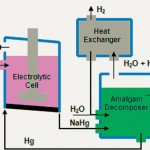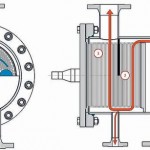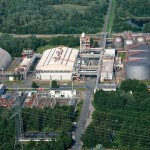The typical applications for welded plate heat exchangers are not restricted to high pressures and temperatures, strong alternating stresses and chemically aggressive media. Their use in chloralkali electrolysis plants shows that heat exchangers with a plate & shell design can also be well suited for improving the operating reliability of, and reducing the necessary maintenance for, technical processing plants at low pressures and temperatures.
Thomas Bieler
In the chloralkali industry, chlorine and other secondary products are manufactured by electrolysis of a salt solution. The mercury or amalgam process is a fundamental manufacturing technology. Here, highly pure sodium chloride is dissolved in water as electrolytic brine. The endothermic reaction takes place in electrolytic cells, in which energy in the form of direct current is fed through electrodes made of mercury and titanium. Elemental chlorine gas forms at the titanium anode and metallic sodium, which is tied up as sodium amalgam, is precipitated at the mercury cathode. This mercury alloy is then broken down with pure water, generating gaseous hydrogen and aqueous caustic soda.
Ineos ChlorVinyls in Wilhelmshaven has arranged a large number of electrolytic cells with downstream amalgam decomposers in so-called cell halls. Installed above the decomposers are heat exchangers, in which the gaseous nitrogen is cooled and then removed for further processing. On entry into the heat exchanger, the nitrogen is saturated with water vapour, which condenses and is fed back into the decomposer after further super-cooling.
The particular challenge lies in the fact that the operating pressure in the electrolytic cell is below 1 bar and a pressure loss is only permissible in the millibar range. In addition to this, particles entrained from the brine tend to settle in the entry area of the heat exchanger, leading to a narrowing of the entry cross-section and thus to a pressure rise as well as back pressure in the electrolytic cell. This results in an impairment of production operation. The apparatus should moreover weigh as little as possible because it is mounted directly on the amalgam decomposers without additional supports.
High heat transfer rates
To ensure trouble-free operation of the plant, Gesmex plate heat exchangers from the XPS range are used. After intensive consultation with Ineos, the plate & shell model – which is proven for condensation tasks – was further developed and optimised for the application. The media are run in a cross flow. On the primary side, the cooling water flows into the flow channels on the plate side at a steep angle over the corrugated pressed plate surfaces. On the secondary side, the gas is conducted on the shell side at a flat angle to the direction of pressing. A deliberately high pressure loss occurs for this reason on the primary side, leading to a limitation of the required cooling water flow owing to the high heat transfer rates. On the secondary side, the gas has little flow resistance to overcome, so that less pressure loss and thus less back pressure occur in the electrolytic cell. The gas is re-directed several times on the shell side and led through the heat exchanger in three passes:
- The first pass contains no heat exchanger plates. Here, the gaseous medium can be calmed and entrained particles lose their energy of flow. A large proportion is returned to the cell due to gravity.
- In the second pass, the water vapour is condensed. The condensate is further cooled, then discharged from the heat exchanger after the second flue and fed back into the electrolytic cell.
- Further cooling of the gas stream takes place in the third pass.
Maintenance made easy
The shell is designed to open at both ends. This special construction allows the plate pack to be withdrawn for inspection and cleaning at planned maintenance intervals. Ineos keeps a replacement plate pack in reserve, to enable the heat exchanger to resume operation after a short shut-down. In addition to this, the openable design permits inspection of the vapour chamber at the gas entry side. If particle accumulations continue to occur after a lengthy period in service, a filter element can be retrofitted and subsequently included in the regular maintenance schedule.
All built-in parts are made of metallic material. The laser welded plate pack is in any case free of seals. Elastomers have likewise been completely dispensed with in the manufacture of flow directors, baffles on the shell side and other installed parts. Leakages attributable to hardened or po-rous materials are thus ruled out in advance. The apparatus is very lightweight. Plate heat exchangers always offer a large exchange surface in a small space. The XPS plate packs are made of plates only 0.6 mm thick. Furthermore, the cylindrical shape is characterised by high stability, so that smaller shell thicknesses can be used. The apparatus boasts external dimensions of 650 x 720 mm and weighs less than 190 kg. The connection geometry is matched to the existing installation. Since the project concerned the replacement of existing apparatus, it was important to restrict expenditure on alterations to the piping to a minimum. Thanks to the individual design of the socket arrangement, the nominal connection sizes and the fitting of connections for additional safety equipment, this requirement was similarly met.
Hall 4.0, Booth M3
Online-Info www.cav.de/2209431
Share:










